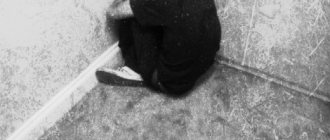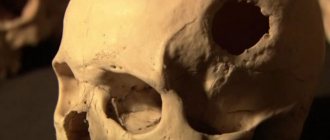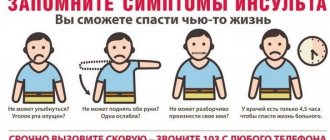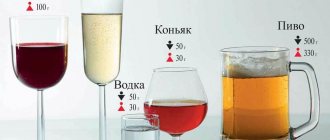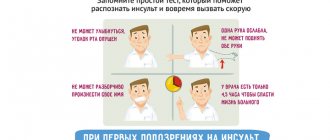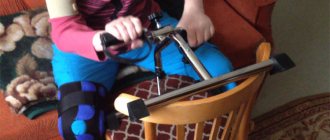Most often, hemorrhagic stroke (HS) is a complication of arterial hypertension. It accounts for 24.4 cases per 100,000 population. It continues to have a high mortality rate and a low prognosis for recovery.
Neurologists are involved in the treatment of strokes of the hemorrhagic type. In some cases, patients may require the help of neurosurgeons. In this article we will consider the features of treating patients with hemorrhagic stroke in the hospital and at home.
The essence and stages of hemorrhagic stroke
Stroke is the death of an area of the brain caused by circulatory problems. A hemorrhagic type of stroke is one of the varieties of the disease, which is based on hemorrhage into the tissue, membranes or ventricles of the brain.
The stages of development of pathological changes are as follows:
- Rupture or weakening with increased permeability of the wall of an arterial or venous vessel responsible for blood supply to the brain (blood inflow or outflow).
- Flow of blood outside the vessel into the cranial cavity.
- Formation of a hematoma (blood clot) or soaking of brain tissue with blood.
- Direct destruction, irritation of brain cells with blood and its breakdown products.
- Compression, displacement of nerve centers located next to the hemorrhage.
- The occurrence of edema of the entire brain, which is compressed in the cavity limited by the bones of the skull.
The result of all these changes is a dysfunction of not only the destroyed nerve cells, but also the entire brain. The larger the hemorrhage in volume, the more pronounced the neurological disorders and the more severe the patient’s condition. There is a risk of sudden respiratory and cardiac arrest.
Causes
The mechanism of development of hemorrhagic stroke, as well as the causes of its occurrence, have been well studied, however, this disease is still difficult to diagnose. To make the doctor’s task easier, as well as to protect yourself from serious consequences, it is worth remembering the factors that can provoke pathology.
Most often, people who suffer from the disease have:
- arterial hypertension and essential hypertension (they account for up to 85% of all diagnoses);
- congenital or acquired vascular aneurysm;
- arteriovenous malformations;
- vasculitis, inflammatory and dystrophic changes in the walls of blood vessels;
- blood diseases in which the process of blood clotting is disrupted, for example, hemophilia;
- cirrhosis of the liver, which entails a decrease in the level of red blood cells;
- congenital defects of cerebral vessels or inflammation of their walls;
- avitaminosis;
- diabetes;
- brain tumors;
- cardiovascular diseases and spinal cord diseases;
- amyloid angiopathy, which is manifested by protein deposition on the walls of blood vessels;
- intoxication.
Important! The risk of developing hemorrhagic stroke increases when taking anticoagulants, fibrinotic agents and other drugs that thin the blood (aspirin, heparin).
In addition, people at risk are those who:
- abuse alcohol;
- smoke;
- use drugs;
- suffer from obesity or lipid disorders;
- abuse fatty and meat foods;
- are constantly in a state of nervous overstrain or are subject to frequent stress;
- suffered sun or heatstroke;
- work hard (meaning physical labor);
- have relatives with such a pathology (in this case we are talking about heredity).
Prevention
Prevention of hemorrhagic stroke can be primary and secondary. In primary cases, it is necessary to promptly identify risk factors for the disease. Patients with a high predisposition are referred to stroke schools. Here they tell you how to minimize the chance of illness.
Secondary prevention is aimed at preventing stroke recurrence. It consists of regularly taking medications, correcting blood pressure, proper nutrition and examination by a doctor.
Lifestyle
The key to primary and secondary prevention is getting rid of stressors. In second place is blood pressure correction. Typically, hemorrhagic stroke occurs in patients with coronary heart disease and a history of diabetes mellitus. Therefore, adequate treatment and prevention of these diseases helps reduce the threat of an attack.
So, the main adjustable factors in lifestyle:
- Increased physical activity;
- Getting rid of stress factors;
- Regular examination and visits to the doctor.
What should I take to prevent GI?
For primary prevention, you should regularly take medications to treat concomitant diseases that lead to stroke. These are hypertension, coronary disease, diabetes mellitus and others.
List of medicines:
- Antihypertensive;
- Statins;
- Disaggregants;
- Antihyperglycemic drugs.
In secondary prevention, therapy is aimed at similar factors. And the list of medications after discharge remains virtually unchanged. It is important to adjust the treatment regimen for arterial hypertension and diabetes mellitus. Here, decompensation of the condition can provoke a recurrence of stroke.
Diet
The transition to a healthy diet should be made after identifying a high risk of stroke (at the stage of primary prevention). Basic recommendations:
- Reducing the amount of animal fats in the diet;
- Increasing the amount of vegetable fats;
- A large amount of vegetables and fruits in the diet (with diabetes, fruits must be reduced);
- Consumption of nuts, legumes, grains;
- Regular inclusion of sea fish in the diet;
- Reducing “red” meat at the expense of fish and “white” meat;
- Increasing the amount of greenery.
Important! Patients at high risk of stroke and after an attack are advised to stop smoking and drinking strong alcohol. The permissible dose is a glass of wine per day.
By the way, do not forget that regular alcohol consumption is associated with the development of colon cancer.
Vitamins
A complex of vitamins for primary and secondary prevention of stroke is selected based on the deficiency of a particular substance. For example, if the content of B vitamins decreases, it is recommended to compensate for the deficiency in tablet or injection form. But prophylactic administration of these drugs is not required.
It is recommended to undergo testing to determine the levels of the following groups of vitamins:
- Group B (B12);
- Vitamin D
The deficiency is corrected by the doctor according to accepted schemes.
Classification
Based on the time elapsed since the development of the pathology, there are:
- An acute period in which the pressure in the cranial cavity increases due to hemorrhage. At this point, blood continues to accumulate, affecting the nervous tissue and causing cerebral edema. The maximum period that the acute period can last is up to 7 days.
- The recovery stage is characterized by the development of reparative processes, blood removal and tissue restoration. It can last up to several months, starting from 2 – 4 weeks.
- Period of residual effects. It lasts for a lifetime. In case of timely provision of qualified medical care, patients not only restore speech and body functions, but also maintain their ability to work.
Depending on the location of the lesion, the following are distinguished:
- Subaranchoidal hemorrhage - characterized by the accumulation of blood under the meninges. Develops as a result of an aneurysm or vascular pathology.
- Parenchymal hemorrhage is the most popular type, characterized by blood entering the brain substance. As a result, a person is diagnosed with a hematoma - a cavity with blood, entailing the death of the cells surrounding it and, thereby, increasing the risk of death or hemorrhagic impregnation. The latter is characterized by blood entering the nervous tissue and manifests itself when vascular permeability increases or anticoagulants are taken. Due to less impact on tissue than in the case of hematoma, the prognosis for its treatment is favorable.
- Intraventricular hemorrhage - fixed when the choroid plexus ruptures and often ends with hydrocephalus and cerebral edema. Despite all the efforts of doctors, such patients die within 2–3 days after the development of a hemorrhagic stroke.
- Sub- and epidural hemorrhages - they are traumatic in nature.
Note! There are also mixed hemorrhages, in which changes occur that are characteristic of different types of stroke.
Depending on the location of hematomas, subdural and intracerebral hematomas are distinguished. The first are found under the dura mater.
Intracerebral strokes can be located in different areas, which is why this type of stroke is divided into:
- lateral – localized in the subcortical nuclei;
- lobar - in the lobes of the brain, capturing white and gray matter;
- medial – in the thalamus zone;
- mixed - hematomas appear in several places at once.
Symptoms
Symptoms such as:
- severe pain in the eyeballs;
- loss of balance;
- tingling or numbness in the legs, arms, or body parts;
- difficulty understanding speech or slurred speech of the person himself.
Such signs are observed in only half of patients with hemorrhagic stroke; the same manifestations may indicate a developed ischemic stroke or transient ischemic attack (popularly called a “micro-stroke”).
A high probability of hemorrhagic stroke is indicated by:
- Dizziness;
- Changes in skin sensitivity;
- Intermittent pulse;
- Flushed face;
- Numbness of one or more limbs;
- Constant headache;
- Attacks of causeless nausea and vomiting that does not bring relief.
Signs of a hemorrhagic stroke in a conscious person:
- Rapidly increasing headache;
- Nausea, vomiting;
- Cardiopalmus;
- Intolerance to bright light, “circles” and “midges” before the eyes;
- paresis, paralysis of arms, legs, facial muscles;
- Difficulty speaking.
There are four clearly defined stages of regression of consciousness:
- Stupefaction – the patient’s blank look, poor response to others;
- Somnolence - reminiscent of sleep with open eyes, gaze directed into space;
- Stupor – resembles deep sleep, weak reaction of the pupils, a light touch to the cornea of the patient’s eye is accompanied by a reaction, the swallowing reflex is preserved;
- Coma - deep sleep, no reactions.
In 65–75% of cases, hemorrhagic stroke occurs during the daytime, when a person is most active. It manifests itself as a sudden loss of consciousness within a few seconds. During this time, patients only have time to utter a sudden loud cry, which is caused by a severe headache, drawing the attention of others. After this, the person loses consciousness and falls.
43-73% of hemorrhages end with a breakthrough of blood into the ventricles of the brain. When blood breaks through into the ventricles, the patient’s condition sharply worsens - coma develops, bilateral pathological signs and protective reflexes appear:
- hemiplegia is combined with motor restlessness in non-paralyzed limbs (violent movements seem conscious (patients pull the blanket over themselves, as if they want to cover themselves with the blanket),
- hormetonia, symptoms of damage to the autonomic nervous system deepen (chills, cold sweats, and a significant increase in temperature occur). The appearance of these symptoms is prognostically unfavorable.
Focal neurological signs are associated with disruption of a certain part of the nervous system. Most often, hemispheric hemorrhages develop, which are characterized by the following symptoms:
- Hemiplegia or hemiparesis is a complete or partial loss of motor activity of the arm and leg, developing on the side opposite to the lesion.
- Decreased muscle tone and tendon reflexes.
- Hemihypesthesia is a disorder of sensitivity.
- Gaze paresis - in this case, the eyeballs are directed towards the lesion.
- Mydriasis - this symptom consists of dilation of the pupil on the side of the hemorrhage.
- Drooping of the corner of the mouth.
- Smoothness of the nasolabial triangle.
- Speech disorders with damage to the dominant hemisphere.
- Development of pathological reflexes.
The progression of the disease and the appearance of cerebral edema are indicated by:
- manifested strabismus;
- sluggish reaction of pupils to light;
- facial asymmetry;
- changes in the rhythm and depth of breathing;
- cardiac dysfunction;
- “floating” movements of the eyeballs;
- severe drop in blood pressure.
The first 2.5-3 weeks after hemorrhage are the most difficult period of the disease, since at this stage the severity of the patient’s condition is due to progressive cerebral edema, which manifests itself in the development and increase of dislocation and cerebral symptoms.
Moreover, brain dislocation and swelling are the main cause of death in the acute period of the disease, when the above symptoms are joined or decompensated by previously existing somatic complications (impaired kidney and liver function, pneumonia, diabetes, etc.).
Forecasts, risks, recovery timelines
Mortality with HI is higher than with cerebral ischemia. In the acute period, it is 40-50% and depends on the size of the damaged vessel. Recovery takes 1.5-3 months, sometimes it can last years. At the same time, about 75% of patients become disabled. The prognosis depends on the volume of hemorrhage, concomitant diseases and the age of the patient. Young people have great potential for rehabilitation.
Risks of hemorrhagic stroke
Prevention of GI is quite difficult. There are no such clear criteria as for ischemic stroke. Both aneurysm and malformation can occur in an absolutely healthy and unexamined person. However, there are people who have a high risk of developing GI. They must be aware of the danger and follow all recommendations of the attending physician.
Risks of GI:
- Hypertension;
- Aneurysms;
- Vascular malformations;
- Other vascular abnormalities;
- Benign neoplasms
- Malignant neoplasms;
- Vasculitis (autoimmune, infectious nature);
- Hemorrhagic diathesis;
- Past inflammation of the brain, spinal cord, meninges;
- Taking drugs (cocaine, amphetamine);
- Regular treatment with anticoagulants.
Diagnostics
If a hemorrhagic stroke is suspected, magnetic resonance or computed tomography of the brain is performed. This allows you to accurately determine the location of the intracranial hematoma, its size, the presence of edema and dislocation of the brain. To monitor hematoma involution, MRI or CT is repeated at certain stages of treatment.
In addition, the following diagnostic methods are used:
- study of the blood coagulation system;
- determination of the content of narcotic substances in the blood;
- angiography (performed for patients with normal blood pressure and when the hematoma is localized in an atypical area);
- lumbar puncture (performed if computed tomography is not possible).
The severity of the condition of a patient who has suffered a hemorrhagic stroke, the degree of disability and survival largely depend on the location of the intracranial hematoma.
Differential diagnosis
Hemorrhagic stroke is differentiated, first of all, from ischemic. Ischemic stroke is characterized by a gradual onset, an increase in focal symptoms and preservation of consciousness. Hemorrhagic stroke begins acutely, with the development of cerebral symptoms. However, at the prehospital stage, it is impossible to carry out differential diagnosis, relying only on the features of the clinical picture of the disease. Therefore, a patient with a preliminary diagnosis of stroke is hospitalized in a hospital, where the necessary studies are performed (MRI, CT scan of the brain, lumbar puncture), which will allow a correct final diagnosis to be made.
Much less often the cause of cerebrovascular accidents are concussions and contusions of the brain, as well as intracranial hematomas of traumatic origin. In the latter case, the development of hemiparesis is preceded by a light interval (the time from the moment of injury to the moment of hemiparesis). In addition, anamnesis - an indication of traumatic brain injury - allows us to assume a traumatic etiology of cerebrovascular accident in this case.
Hemorrhagic stroke must be differentiated from hemorrhage into brain tumor tissue, in particular spongioblastoma multiforme. Suspicion of the tumor nature of the disease may arise if there is a history of prolonged headaches, changes in the patient’s personality that preceded the onset of hemiparesis.
In relatively rare cases, there is a need for differential diagnosis of hemorrhagic stroke and the condition after partial (Jacksonian) epileptic seizures.
Consequences
The consequences of a hemorrhagic stroke are very serious. If the victim manages to survive, he will face a long recovery period and severe disability.
The reason for this is that doctors often cannot perform surgery on the damaged vessel due to its deep location in the brain. External hemorrhages located between the shell of the skull and the brain are easier to operate on. But such injuries can quickly lead to irreversible consequences even before surgery.
The consequences of a stroke depend on which hemisphere is affected. In this case, the lesions affect the opposite side of the body. If the blow occurred in the left hemisphere, the paralysis will affect the right side, and vice versa.
Stroke hemorrhagic left side
A stroke in the left hemisphere of the brain occurs in 57% of cases of hemorrhagic stroke.
Since the left hemisphere is speech and logic, problems with speech always arise with a left-sided stroke. The victim begins to speak indistinctly, often being able to pronounce only some fragments of words or sounds. At the same time, he does not perceive the information he hears well.
The patient loses the ability to write and read, and loses speech memory. Paralysis affects the right side of the face and limbs.
Stroke hemorrhagic right side
With a right-sided impact, there are no speech abnormalities. Doctors say that such a stroke is more difficult to diagnose, since it does not have such a pronounced clinical picture. With a stroke on the right side, precious time is often lost, which leads to irreversible death of cells in the brain. As a result of this stroke, the left side of the face and body are paralyzed.
Other consequences of a right-handed impact:
- sensations and perceptions are disturbed - often the patient seems to have many immobile limbs. Or alienation of the body arises;
- clear signs of amnesia appear, the person is unable to remember his actions;
- the victim incorrectly estimates the size of objects, distances, and is poorly oriented in space;
- the skills of properly putting on clothes and shoes are lost;
- depressive states, apathy.
Coma
Approximately 90% of patients with GI in a state of stupor or coma die in the first five days, despite intensive therapy
Disorders of consciousness are characteristic of many pathologies, manifested by inhibition of the functions of the reticular formation of the brain.
Brain dysfunctions develop under the influence of:
- Endo- and exotoxins – derivatives of the end products of metabolism;
- Oxygen and energy starvation of the brain;
- Metabolic disorders in brain structures;
- Expansion of the volume of brain matter.
The most important factors in the development of coma are acidosis, cerebral edema, increased intracranial pressure, and impaired microcirculation of brain fluids and blood.
The state of coma affects the functioning of the respiratory system, excretion (kidneys) and digestion (liver, intestines).
It is impossible to recover from a coma at home, and it is very difficult even in intensive care conditions.
The clinical definition of coma is carried out using the GCS (Glasgow Coma Scale), and some other methods that are important for clinicians are used. There are precoma and four stages of coma. The easiest is the first, and the hopeless state of the patient corresponds to the fourth stage of coma.
Rehabilitation objectives
The main goal of rehabilitation is for the patient to achieve the required level of social adaptation. This must be done in any case, regardless of the severity of the disease. The task is completed in several ways:
- teaching the victim new skills and abilities that he previously had;
- adaptation of a person to existing moral and physical deviations after suffering a pathology.
On this topic
- Stroke
7 facts about ischemic stroke of the right hemisphere of the brain
- Natalia Sergeevna Pershina
- May 25, 2020
It is important to know that even professional rehabilitation cannot always help the victim recover completely. The objectives of rehabilitation measures are to mobilize the patient’s strength and give him self-confidence for a further full life.
The main goal of the hospital stage of rehabilitation is maximum compensation of the patient’s abilities lost due to damage to the centers of the nervous system. The beginning, content and duration of medical measures aimed at rehabilitating the patient are determined not only by the nature of the pathology, but also by the degree of functional deviations caused by the abnormal condition.
What to do if you have a stroke?
If you suspect a cerebral hemorrhage, you should call a doctor or ambulance as soon as possible.
Under no circumstances should the patient stand up, walk, or move around with the help of relatives. Treatment of hemorrhagic stroke should be started as early as possible. When the necessary measures are taken in the first 6 hours from the moment the attack occurs, the likelihood of a favorable outcome increases significantly.
Treatment of cerebral hemorrhages should be carried out only in specialized clinics, and in the first week it is advisable to place the patient in the intensive care unit under constant medical supervision. Subsequently, if the course is favorable, the patient is transferred to a specialized neurological or department for patients with vascular pathology of the brain. It is important that the hospital has the ability to conduct round-the-clock diagnostic procedures such as CT and MRI, as well as the possibility of emergency neurosurgical intervention.
First aid for a hemorrhagic stroke will be provided by the ambulance team at the pre-hospital stage and on the way to the hospital. It includes:
- Transporting the patient in a lying position with the head end elevated;
- Normalization of blood pressure by administering antihypertensive drugs (clonidine, dibazol, enalapril);
- Combating cerebral edema with osmotic diuretics (mannitol);
- The use of drugs aimed at stopping bleeding (etamzilate);
- Administration of anticonvulsants if indicated, sedative therapy (Relanium);
- Maintaining, if necessary, the function of external respiration and cardiac activity.
Further treatment of hemorrhagic stroke in a hospital setting can be conservative and surgical.
Stroke surgery
Surgical treatment is carried out in the neurosurgery department, as a rule, in the first three days from the onset of the disease. Indications for surgery for hemorrhagic stroke are:
- Large hemispheric hematomas;
- Breakthrough of blood into the ventricles of the brain;
- Aneurysm rupture due to increased intracranial pressure.
Removing blood from the hematoma is aimed at decompression, that is, reducing pressure in the cranial cavity and on the surrounding brain tissue, which significantly improves the prognosis and also helps save the patient’s life.
Non-surgical treatment
For small hemorrhages, treatment with conservative methods is possible. Conservative therapy is also used as a logical continuation of treatment after neurosurgical operations. The goal of therapy is to eliminate damage and prevent possible complications of hemorrhagic stroke. In the most acute period of a stroke, the patient is in intensive care, where measures are taken to maintain the vital functions of the body. The following are produced in parallel:
- Correction and stabilization of blood pressure. Hemorrhagic stroke most often develops against the background of primary or symptomatic arterial hypertension. Drugs from the groups of beta-blockers, ACE inhibitors, and antispasmodics are prescribed.
- Elimination of cerebral edema. For this purpose, oxygen therapy is performed by directly introducing oxygen into the lungs. The hematoma is eliminated either surgically or by draining the affected area. The patient is provided with maximum rest, anticonvulsants, analgesics, vascular-strengthening drugs are prescribed, and, if indicated, diuretics.
- Stop bleeding, prevent thrombosis and repeated hemorrhages. The problematic vessel is treated surgically, and the patient is prescribed vasoconstrictor drugs.
- Sedative therapy. In the most acute and acute period of hemorrhagic stroke, the patient must be provided with maximum rest and sleep. The patient is prescribed Elenium or phenozepam, sleeping pills. External irritants are eliminated as much as technically possible.
Specific drugs and their combinations are selected by the doctor depending on the characteristics of a particular case and the patient’s response to treatment.
Major stroke: consequences for the brain and chances of survival
A major stroke is a deadly disease. Every year more and more cases of brain damage are registered.
How dangerous is this disease? How to provide first aid? What can be the consequences of a major stroke, how high are the chances of survival and how is rehabilitation carried out? Let's find out!
Differences from other forms
A major stroke is damage to the brain. Unlike other forms, this type of disease leads to more serious consequences, and in many cases even death .
With this disease, a large area of the brain is affected , including large blood vessels. If the left hemisphere is affected, the person cannot formulate sentences and cannot control the right side of the body. With more extensive brain damage, hearing and vision are affected.
Prevalence and development
According to statistics, more than 400 thousand patients with this diagnosis are registered in Russia every year, and 35% of them die. Around the world, there are approximately 12 million people affected by this disease every year.
A major stroke develops due to the formation of blood clots in large vessels. They cause either narrowing of the lumen or rupture of the vessel. In both cases, the disease develops.
Classification
The disease is divided into three main types : ischemic, hemorrhagic and stem.
Ischemic
Extensive ischemic stroke is more common than others , but its consequences are much milder than other forms. It is caused by blockage of one or more large vessels of the brain. This type can be caused by either a blood clot or a plaque. In rare cases, the disease develops due to a sharp decrease in blood pressure.
There are several types of ischemic stroke:
- lacunar infarction (cavities form in the brain - lacunae);
- cardioembolic (partial blockage of an artery);
- microocclusive (blood flow is disrupted);
- atherothrombic (impaired blood flow occurs due to a blood clot that has separated from the wall of the vessel);
- hemodynamic (occurs due to a sharp jump in blood pressure).
Hemorrhagic
In a hemorrhagic stroke, blood leaks into the brain tissue . A major stroke with cerebral hemorrhage is much less common, but its consequences are much more dangerous.
The following factors lead to it: very high blood pressure (the walls of large vessels burst), congenital defects and aneurysms of cerebral vessels, the consequences of hypertension or other diseases that lead to thinning of the walls of blood vessels.
There are two types of hemorrhagic stroke of the brain:
- intracerebral (occurs due to a sharp drop in blood pressure, more often observed in older people);
- subarachnoid hemorrhage (occurs due to a ruptured artery, this type is dangerous for obese people).
About the difference between ischemic and hemorrhagic forms, their symptoms and treatment - the following video:
Stem
With the stem type, not the entire brain suffers, but only its base, but this is where the main vital centers are located : breathing, swallowing, heartbeat, etc.
Therefore, this type leads to death in almost 100% of cases.
Causes of development and risk factors
The disease is dangerous for any age category (except children), but the causes of its occurrence and risk factors vary slightly.
- Young people (up to 40 years old) . At this age, hemorrhagic major stroke is more common. Young people who abuse drugs and cigarettes are at risk.
- Middle-aged people (40-60 years old) .
Men aged 40-50 years are more susceptible to this disease than women, but by the age of 60 the rates level out. The thing is that men aged 40-50 years are 19% more susceptible to atherosclerosis than women. By age 60, this percentage drops to almost zero. - Elderly people (over 60 years old) .
At this age, the risk of occurrence is very high (increases almost 18 times). In people over 60 years of age, plaque forms on the inner surface of blood vessels, which leads to blockage or rupture and subsequent bleeding. Heart disease leads to the formation of blood clots. In older people, blood pressure can be high for a long time, which eventually leads to rupture of blood vessels.
People with diabetes and heart disease are more likely to have a stroke. Any vascular pathologies and heart diseases (blood flow disorders) also increase the risk of developing the disease.
Symptoms
Symptoms of the disease are noticeable even to those people who are unfamiliar with medicine:
- loss of the ability to formulate simple sentences (if you ask a person to say a phrase, he will not be able to do it);
- violation of facial symmetry (the first thing that catches your eye is a crooked smile);
- severe weakness in an arm or leg (one leg will drag when walking, and if a person raises his arms up, one of them will be lower);
- the person has very severe headaches;
- consciousness is impaired, the patient may fall into a coma;
- perception is impaired: a person who is affected by this disease does not understand speech and cannot read the text;
- coordination is impaired (the gait becomes “drunk”).
First aid
Stroke in almost all cases develops rapidly and suddenly. It can strike a person at any time and anywhere, so everyone should know how to properly provide first aid:
- Carefully place the victim on a hard surface and call an ambulance.
- If a person is vomiting, turn their head to the side.
- Unbutton your collar, remove your tie, and free your neck to breathe.
- Open the window: the victim needs fresh air.
- Never give the patient food, water or any medications.
- Rub and massage the paralyzed arm or leg.
Diagnostics
There are diseases whose symptoms are very similar to a major stroke, so diagnosis is simply necessary. The main examination that should be performed first is a computed tomography scan. It is with its help that the doctor finds the lesion and determines the type of extensive stroke (hemorrhagic, ischemic or brainstem).
After a computed tomography scan, the patient will be prescribed an ultrasound of the brain, an EEG and blood tests (general and biochemical blood tests).
Another effective diagnostic method is MRI, but due to the very high cost, this examination is not yet in great demand.
Treatment tactics
very important to start treatment in the first three hours after the onset of the disease, since in this case the chances of recovery increase significantly. The patient is hospitalized, examined, the type of stroke is determined, and treatment begins.
First of all, doctors restore blood flow with the help of drugs that destroy blood clots, reduce body temperature (if it is elevated) and normalize blood pressure . Be sure to check your blood sugar levels.
In case of major ischemic stroke, a drug called Alteplase is used to destroy blood clots. This remedy effectively restores blood flow, but it has contraindications:
- more than three hours have passed since the onset of the disease;
- as the disease progressed, hemorrhage occurred in the brain cavity;
- the patient's age is more than 80 or less than 18 years;
- systolic blood pressure exceeds 165 mm Hg. Art.
For intravenous infusions, saline solution , to which the necessary drugs are added. Other solutions cannot be used, since during a stroke there is a high risk of developing cerebral edema, to prevent it the patient is prescribed furosemide, magnesia or mannitol.
In order to prevent the development of severe infections, the patient is prescribed antibiotics . Neurotrophins will help restore the functioning of nerve cells : Cortexin and Cerebrolysin. Thanks to them, it is possible to almost completely restore the functioning of the affected limbs.
If the stroke was caused by a ruptured vessel and severe bleeding, there is a high probability of surgical intervention , since the blood must be removed. During treatment in a hospital setting, the functions of damaged body systems are restored.
If the patient falls into a coma, it is necessary to prevent bedsores.
Rehabilitation
Rehabilitation after treatment for a major stroke can last for many years. During the recovery period, the patient must observe the following points:
- taking medications that reduce the risk of recurrence of the disease;
- adherence to a special diet (foods that contain cholesterol are completely excluded from the menu: mayonnaise and various sauces, eggs, fatty meats, caviar, sweet and spicy dishes; food suitable for cerebral atherosclerosis);
- physiotherapy (swimming, exercises on special simulators, therapeutic exercises), psychotherapy and regular sessions with a speech therapist (these measures are aimed at restoring speech and motor functions, and a psychiatrist will help improve thinking).
Survival prognosis
Is it possible to survive a major stroke? Survival rates among people who develop it are low.
If treatment was started in the first three hours, the prognosis for recovery is 30%, but in most cases this figure is closer to 5-10%. The prognosis of patients who fall into a coma due to a major stroke is unfavorable - only 20% of cases survive.
A person who has suffered this disease becomes disabled . Global changes occur in his behavior: he may not recognize his loved ones, does not understand the purpose of some things familiar to him, and his speech and concentration are often impaired. Many patients are unable to move fully; one side of the body most often remains paralyzed.
People who have had a stroke become irritable, a little slow, and their memory noticeably deteriorates. Patients often suffer from depression . Along with speech impairment, visual function suffers and strabismus develops.
Relapse prevention and prevention measures
In order to reduce the risk of developing a major stroke, the following preventive measures should be followed:
- control your blood pressure: have a home blood pressure monitor with you - if your blood pressure constantly rises, consult your doctor;
- watch your diet, exclude harmful foods from the menu;
- walk more in the fresh air, do simple physical exercises;
- don’t be nervous, avoid stress;
- Watch your body weight: obesity leads to thrombosis.
A major stroke is a very dangerous and insidious disease. It is important to provide assistance in the first three hours after the onset of the disease , since it is in this case that the chance of recovery increases. Monitor your health and if you have any ailments, go to the hospital.
Source: https://oserdce.com/sosudy/insulty/obshirnyj-ins.html
Recovery period
Recovery after a hemorrhagic stroke is long. It depends on the lost functions and does not guarantee their complete rehabilitation. Lost abilities are restored most quickly in the first year after a stroke, then this process is slower. The neurological deficit that remains after three years will most likely remain for life.
Neurologists and rehabilitation specialists are ready to help restore lost functions as much as possible. For this:
- for paresis or paralysis, physiotherapy is carried out (for example, on the Myoton apparatus), massage and exercise therapy are performed with an instructor;
- if speech reproduction is impaired, the person will have to work with a speech therapist;
- classes are held with a psychologist or psychotherapist;
- if reading/writing skills are lost, classes are held to restore them;
- drugs are prescribed that will help restore lost neural connections (“Cerakson”, “Somazina”), reduce high blood pressure (“Enalapril”, “Nifedipine”), antidepressants and sedatives;
- hydrotherapy is carried out (massage in the pool, light exercises in the water);
- classes on special simulators;
- color therapy - treatment with visual images.
Only when the patient and the doctor unite in the fight against the consequences of a hemorrhagic stroke can it be defeated, restoring lost capabilities as much as possible, including at home.
Treatment at home
After discharge, the patient must take a whole group of drugs that prevent recurrent attacks and improve the recovery of lost functions. The patient is also advised to monitor the course of concomitant diseases.
Groups of drugs after hemorrhagic stroke:
- Antihypertensive drugs. Normalization of blood pressure is a fundamental point in the prevention of both ischemic and hemorrhagic stroke. The prescription of medications for hypertension should be carried out after an examination (ECHO-CG, ECG, possibly Holter) and together with a cardiologist. Monotherapy and prescription regimens are used. The main drugs are beta blockers, ACE inhibitors, calcium channel blockers, diuretics and others;
- Disaggregants and anticoagulants. Use with caution after hemorrhagic stroke. On the one hand, any inflammatory process increases the risk of thrombosis, on the other hand, recurrent bleeding is possible. The decision to extend the course or prescribe new drugs is made by the attending physician, taking into account the results of the latest examinations and concomitant pathology;
Interesting! European studies show that taking antiplatelet drugs does not increase the risk of bleeding. Therefore, they can continue to be used after GI if indicated. But anticoagulants should be discontinued after an attack for at least 4 weeks.
- Lipid-lowering drugs. Used in elderly people in complex therapy. The course of hemorrhagic stroke is only indirectly affected;
- Neuroprotectors. Can be used by courses. There are tablet and injectable medications. These include vinpocetine, cerebrolysin, piracetam, mexidol, mildronate, actovegin, choline alfoscerate, citicoline. Prescribed by your doctor, taking into account associated side effects.
How often do you undergo medical examination?
After stroke of the hemorrhagic type, the patient is observed by a therapist and a neurologist at the local clinic. Tests, blood pressure are monitored regularly, and medications are prescribed for treatment.
Important! Clinical monitoring of arterial hypertension and correction of blood pressure numbers is one of the main directions for the prevention of secondary hemorrhagic stroke.
Some operations performed for GI require postoperative monitoring. This requires a repeat MRI or MR angiography, and based on the results, a consultation with a neurosurgeon.
A patient after an acute stroke must attend a stroke school, undergo rehabilitation treatment courses in a rehabilitation center or a day hospital at a clinic at least 2 times a year. It is important to promptly treat the concomitant pathology that leads to GI.
Important! Giving up bad habits and maintaining a healthy lifestyle is often more important than taking medications. Risk factors are discussed in detail in stroke schools.
Diet
There is no specific diet after a hemorrhagic stroke. Nutrition should be selected taking into account concomitant pathology. Typically, a patient with HI has diabetes mellitus, coronary heart disease, and arterial hypertension. Therefore, it is necessary to adhere to a low-carbohydrate diet or follow the principles of the “Mediterranean diet”. With hypertension, it is necessary to limit the amount of salt in the diet.
Daily regime
Returning a patient home after hospitalization will require changes. Especially when there is a pronounced neurological deficit.
What needs to be changed?
- Limit or eliminate exposure to stress;
- Perform exercises from the exercise therapy complex daily. After recovery, you can move on to fitness, walking, swimming;
- Provide yourself with regular rest and sleep of at least 8 hours;
- Change your diet, include elements of proper nutrition, eliminate alcohol and smoking;
- Do not only physical exercises every day, but also intellectual ones (learn new languages, dance, read books).
Interesting! When are elective interventions (dental care, non-urgent surgeries) performed after a hemorrhagic stroke? It is recommended to limit all manipulations in the first six months after stroke. Emergency assistance can be provided at any time.
Exercise therapy
Rehabilitation gymnastics is developed by a physical therapy instructor individually for each patient. The complex should also be performed at home. If there is a pronounced limitation in the mobility of the limbs, then passive development is performed by an assistant or specialist.
In addition to limb mobility, there are gymnastics complexes for restoring speech, vision and even memory. You can learn more about rehabilitation after a stroke by following the link.
Return to work
The decision on the possibility of continuing to work is made by a medical advisory commission. When conducting a medical and social examination, the percentage of lost functions and the possibility of rehabilitation are assessed, and an individual program is developed for each patient.
According to statistics, only 20% of patients return to work after a stroke. This percentage is higher in the group of young people. Rehabilitation of patients of retirement age is aimed at restoring mobility and self-care skills. In addition, attention should be paid to maintaining the patient's mental abilities and preventing dementia.
Attention! A referral for MSE is made by the attending physician. But the patient can submit documents for examination himself. To carry out the examination, the latest epicrisis from the hospital, a list of examinations and fresh tests are required.
Folk remedies
We can talk about treatment with traditional methods only when the patient’s condition has stabilized and his life is no longer in danger. Such funds are aimed at eliminating the consequences of a stroke, stimulating nervous tissue, and providing active restorative therapy for both brain tissue, nerves and muscles, and for the entire body. In general, a large article, “Rehabilitation after Stroke,” posted on our website, is devoted to intensive recovery after hemorrhagic and ischemic stroke.
Strict nutritional correction is the first step to successful recovery after a stroke. It is necessary to give up fatty, meat, sweet foods and alcohol, and optimally balance the diet.
And many folk remedies perfectly and safely stimulate cell regeneration and restoration of innervation.
- Tincture of young pine cones. Young pine cones are infused with vodka for a month. Take it three times a day, 1 teaspoon. This tincture helps strengthen the vascular wall, normalizes blood pressure, restores skin sensitivity, innervation of the limbs, and strengthens muscle tissue.
- Pine or flower pollen. Pollen is a powerful natural remedy for strengthening the vascular wall, nourishes the body's cells and saturates them with antioxidants and vitamins. Recommended daily use as a food supplement. You can consume up to a tablespoon of the product per day.
- Decoction of birch leaves. An excellent tonic that cleanses the blood and blood vessels of toxins and improves immunity. Crushed birch leaves are boiled for about 15 minutes, and then infused for several hours in a thermos. The decoction can also be replaced with a tincture of birch leaves in alcohol.
- Walnut partitions + hawthorn. Alcohol tincture of hawthorn is poured into a small amount of the partitions of young nuts and left for 2 weeks.
- Mumiyo with aloe. Shilajit promotes active resorption of blood clots and stimulates cell regeneration. Shilajit powder is mixed with aloe juice and the resulting medicine is drunk for 10 days. The break is 4 days, and then the course is repeated.
- Echinopsia. Another name for the plant is mordovnik. Its alcohol infusion helps eliminate paralysis, as it stimulates the innervation of muscle tissue. The remedy is infused for 21 days, and the course of treatment lasts several weeks.
- Chestnut tincture. The medicine is prepared from horse chestnut peel, which is crushed and infused in alcohol for 3 days. Chestnut successfully relieves cerebral edema after a stroke.
The above folk remedies help to more quickly treat the consequences of a stroke and restore lost abilities.
What to be prepared for after a cerebral hemorrhage
The consequences of a cerebral infarction can be expressed as follows:
- Partial or complete paralysis of the body;
- Paresis (numbness) of the limbs;
- The patient may lose the ability to walk and navigate in space;
- Impaired speech communication;
- Inability to swallow;
- Deafness, complete or partial;
- Changes in mental state;
- Inability to control urination and bowel movements;
- The need for constant care.
No doctor can answer the question about the patient’s further condition after a stroke; everything is very individual. But there are several signs that suggest the development of an unfavorable prognosis in an elderly person:
- Location of the lesion in the brain. If its most important centers are affected, the outcome will be fatal.
- The area of spread of hemorrhage, affecting the loss of many body functions.
- The most severe consequences are observed in patients with hypertension and atherosclerotic plaques on the vessels of the brain.
- A coma caused by cerebral edema sharply worsens the prognosis.
- A recurrent stroke usually ends in the death of the patient.
Factors that can lead to rehabilitation and recovery of an elderly patient:
- The hematoma is small in size, as confirmed by laboratory tests;
- The patient does not lose consciousness;
- Absence of heart disease, atherosclerosis of the head and neck vessels;
- Normal blood pressure.
Calling a doctor in a timely manner is of great importance. When admitted to the hospital within the first 6 hours, the likelihood of a favorable outcome of the disease increases significantly. The life of an elderly patient often depends on the experience and skillful actions of the specialist who comes to the call.
Typically, ischemic stroke is preceded by transient attacks. It is the recognition of the signs of these disorders and their treatment that will prevent the development of severe pathology of the cerebral blood supply. Prolonged post-stroke coma often leads to the death of the patient.
For patients over 80 years of age, the prognosis after a stroke is usually poor. This is primarily due to the presence of concomitant diseases and lack of support from a weakened immune system.
Often the likelihood of a cure is reduced due to the provision of unqualified care and the lack of opportunity to buy expensive medicines and pay for doctors’ services.
A patient over 80 years of age, more often than a young person, finds himself after a stroke in a state of coma, characterized by a loss of the body’s response to external impulses and an unconscious state.
The main signs of coma are that the patient cannot breathe on his own, blood circulation is impaired due to a drop in pressure in the vessels, and a constant state of fever. In most patients, if the coma lasts more than 7 days, death occurs.
When a stroke occurs in the left hemisphere, there is complete or partial paralysis of the right side of the body. The patient loses the ability to pronounce long phrases, understanding speech, he can only answer in monosyllables or in separate words.
When the right hemisphere is damaged, the motor function of the limbs on the left side is impaired. An elderly patient loses memory for immediate events, clearly remembering his past, his facial expression changes, as paralysis of his half occurs, and coordination of movements is impaired.
It is impossible to give a favorable prognosis after a stroke in elderly patients even if all recommendations are followed. However, you can significantly reduce the risk of a recurrent attack by changing your lifestyle for the next year allocated for rehabilitation:
- For elderly patients, proper nutrition is of particular importance: cereals, whole grain bread, vegetables and fruits. Even if there is no appetite, you still need to eat food, since the body needs support during the recovery period.
- Often, older patients experience complete or partial paralysis of the body. An anti-decubitus mattress will help prevent the development of skin infections. The patient needs to regularly change body position.
- Swelling of the legs develops gradually. To prevent it, diuretics are prescribed.
- Treatment of concomitant diseases is necessary.
Modern medicine believes that taking maintenance medications for older patients helps reduce the rate of ischemic attack and expand the “therapeutic window” (the period immediately after hemorrhage).
Constant use of such medications should be under medical supervision.
Thus, stroke is especially dangerous for older patients. The main consequence of an attack can be partial or complete paralysis of the body, leading to the inability of the patient to self-care. Visual and auditory dysfunctions are also common.
The patient’s psyche may change, he becomes whiny or, conversely, aggressive. The main goal of treatment and recovery after a stroke is to prevent another attack, which often ends in the death of the patient.
Source: stopinsult.ru
Numerous studies have shown that stroke occurs much more often in older people. The main reasons for this are irreversible age-related changes in the structure of the brain. The disease is much more severe in old age, and the prognosis for recovery is not always favorable. Regardless of the type of stroke, older patients rarely receive effective treatment, so many do not receive adequate treatment.
Forecast for life
Unfortunately, about 70% of patients with hemorrhagic stroke die. This mainly happens for the following reasons:
- old age (over 70 years);
- severe concomitant diseases (heart, lungs, internal organs);
- large amounts of hemorrhage;
- breakthrough of blood into the ventricles of the brain;
- localization of stroke in the brain stem.
If these factors are not noted, the prognosis for life is favorable. Early initiation of treatment (in the first 3 hours after the onset of a stroke), persistent and long-term rehabilitation (about a year) increase the chances of a person’s full recovery. At the age of 45–56 years, with small hemorrhages in the cerebral cortex, this is possible.
Where is the best place to treat a stroke?
The only “stroke network” in Russia operates in Moscow. This is a list of clinics located throughout the city. They accept patients with acute stroke around the clock. There are opportunities here for quick verification of the diagnosis, initiation of treatment and surgical intervention.
List of clinics:
- City Clinical Hospital No. 1 named after Pirogov;
- Konchalovsky Clinical Hospital;
- State Clinical Hospital named after S.S. Yudin;
- State Clinical Hospital named after Veresaev;
- City Clinical Hospital No. 31;
- Research Institute named after N.V. Sklifosovsky;
- Botkin State Clinical Hospital;
- City Clinical Hospital named after Buyanov;
- City Clinical Hospital No. 15;
- City Clinical Hospital named after Davydovsky.
In other cities, patients with strokes are admitted to clinics that have neurosurgical and endovascular departments.
Hemorrhagic stroke is a serious and dangerous disease. It is easier to prevent it than to treat the consequences of the disease. Be attentive to your health and the well-being of your loved ones!

